Ir y volver, 2019
Single channel video | 12'52" | HD, color, sound | 16:9
I write with water the sentence “A la esperanza vuelvo” on a light blue wall by the river. As the sun erases the words, I keep writing it over and over again, until I run out of water. Ir y volver was first presented as a performance in Matanzas, Cuba, for the XIII Bienal de La Habana. “A la esperanza vuelvo” is a verse by Carilda Oliver Labra, a Cuban poet who has always lived there.
Escrevo com água a frase “A la esperanza vuelvo” sobre uma parede azul-clara junto ao rio em Matanzas, Cuba. Enquanto o sol apaga as palavras, continuo escrevendo repetidas vezes, até acabar água. Ir y volver foi apresentado pela primeira vez como uma performance na XIII Bienal de La Habana, em Matanzas, Cuba. “A la esperanza vuelvo” é um verso de Carilda Oliver Labra, poeta cubana que viveu lá toda sua vida.
Los cuatro puntos cardinales son tres: el Sur y el Norte, 2019


The title Los cuatro puntos cardinales son tres: el Sur y el Norte (The four cardinal points are three: the South and the North) is a verse by the Chilean poet Vicente Huidobro. Using internal contradictions in the construction of the verse, Huidobro clarifies relations of hierarchy, power and exploitation between North and South. The sculpture is a weather vane that continues to reduce the four cardinal points to one, claiming a southern view of the world.
O título Los cuatro puntos cardinales filho tres: el Sur y el Norte (Os quatro pontos cardeais são três: o Sul e o Norte),é um verso do poeta chileno Vicent Huidobro. Usando contradições internas na construção do verso, Huidobro esclarece relações de hierarquia, poder e exploração entre o Norte
e sul. A escultura é um cata-vento que continua a reduzir os quatro pontos cardinais a um, reividicando uma visão sulista do mundo.
Bienvenidos, 2017

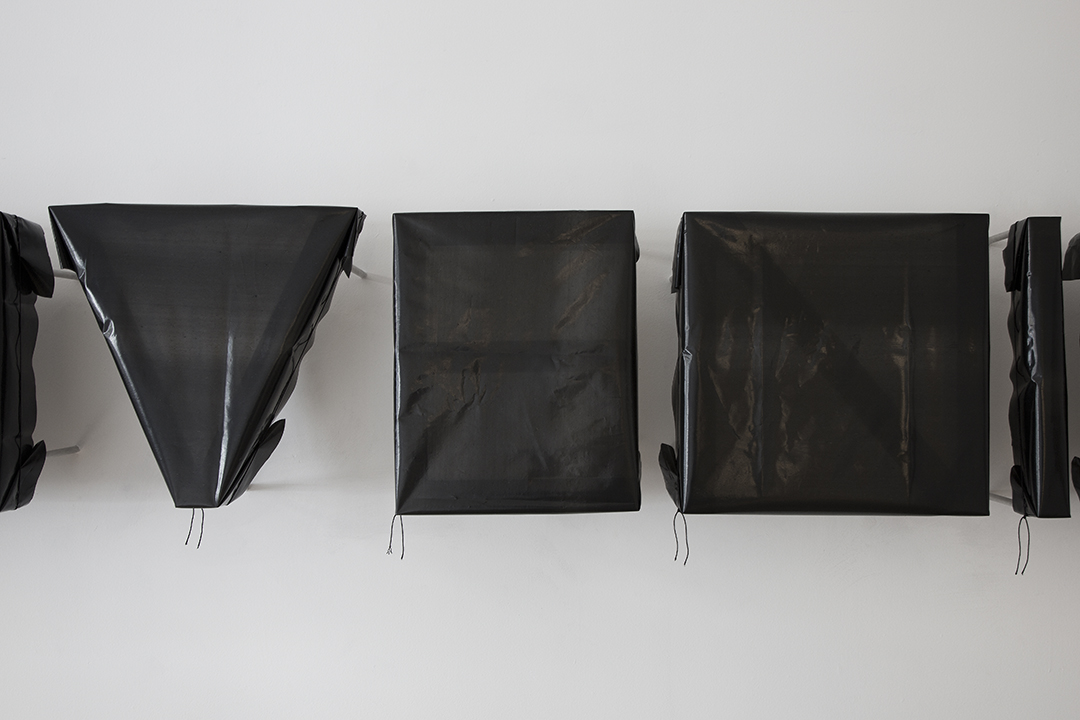
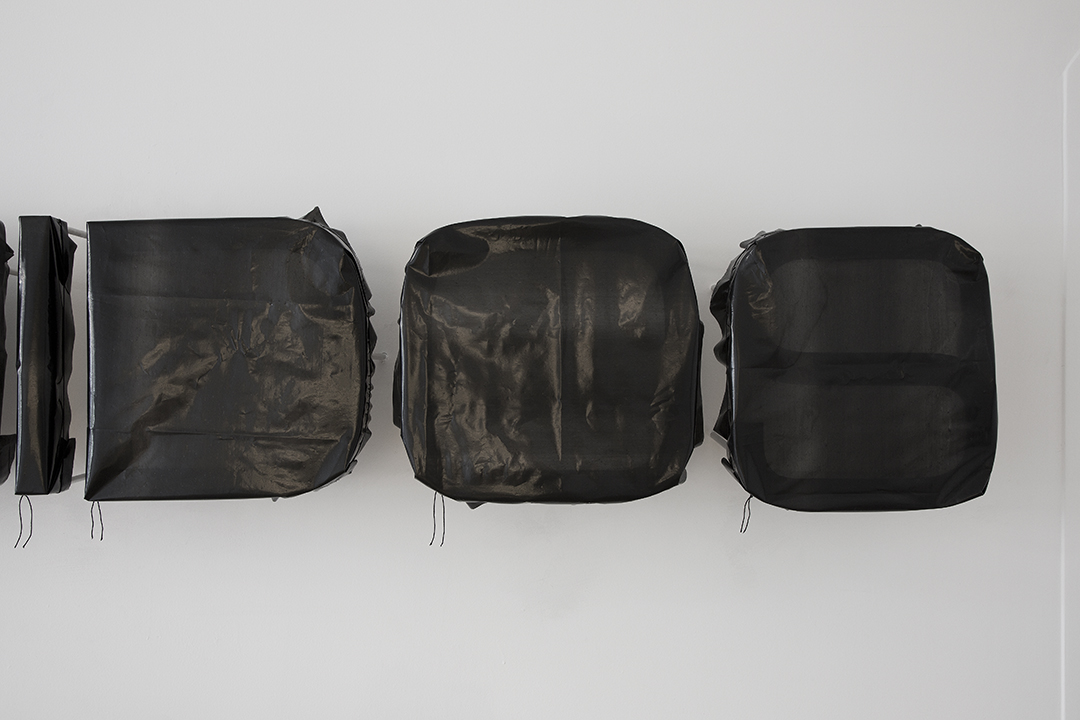


Exhibition view: Bienvenidos, ArredondoArozarena, Mexico City, 2017
Aluminum sign, black plastic | 360 x 35 x 5 cm (141.73 x 13.78 x 1.97 in)The migration route is one marked by signs, perverse terms and procedures. The greeting signal that every border crossing confers its visitors, is not destined for all.
* Excerpt from text by Tatiana Cuevas on the exhibition
A rota de migração é marcada por sinais, termos e procedimentos perversos. O letreiro de saudação que toda passagem de fronteira confere a seus visitantes não é destinado a todos.
*Trecho do texto de Tatiana Cuevas sobre a exposição Bienvenidos
Ominosos, 2017


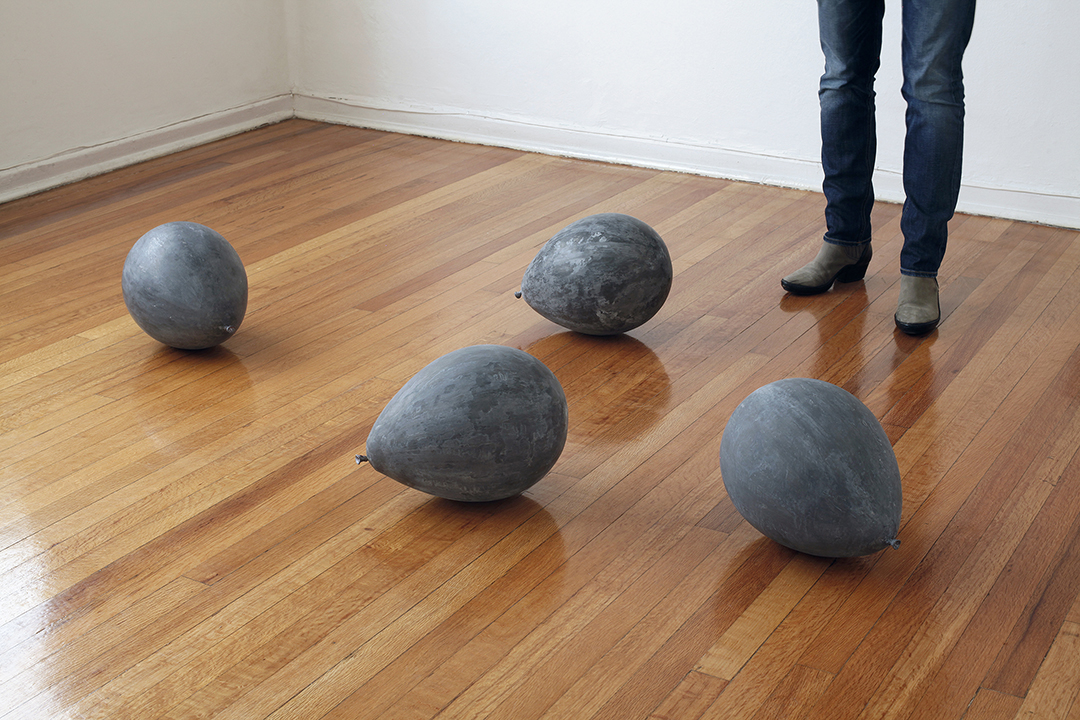

Exhibition view: Bienvenidos, ArredondoArozarena, Mexico City, 2017
21 Lead sculptures | 9.06 x 11.81 in (each)When in 2014 the United States declared a migratory crisis considering the sudden increase of children detained on the US-Mexico border, and the first deportation of a group of children to San Pedro Sula, Honduras occurred, the very prestigious news agency Reuters reported the event with disconcerting ingenuity: “Looking happy, the deported children left the airport under a cloudy sky and a hot afternoon. One by one, they got on a bus, playing with balloons that had been given to them”. For Marilá Dardot, an artist whose attention is focused on the fragile intersection between language and its supports (the word, the page, the book, the wall) and who has explored the terms of that relationship in political speech and its discrepancies, that feeble and quiet signal of the return to innocence that expressed the tragedy of a hopeless journey. In reproducing these globes with the ominous weight of lead, Dardot alludes to the transnational resistance to recognize the shared responsibility of this exodus, as well as to the physical threats that chase migrants beyond their places of origin.
* Excerpt from text by Tatiana Cuevas on the exhibition
Quando, em 2014, os Estados Unidos declararam uma crise migratória, considerando o súbito aumento de crianças detidas na fronteira EUA-México, a prestigiada agência de notícias Reuters relatou a primeira deportação de um grupo de crianças para San Pedro Sula, Honduras, com desconcertante ingenuidade: “Parecendo felizes, as crianças deportadas deixaram o aeroporto sob um céu nublado e uma tarde quente. Uma a uma, pegaram um ônibus, brincando com balões que lhes haviam sido dados”. Para Marilá Dardot, uma artista cuja atenção se concentra na frágil intersecção entre a linguagem e seus suportes (a palavra, a página, o livro, o muro) e quem explorou os termos dessa relação na fala política e suas discrepâncias, esse débil e silencioso retorno à inocência expressou a tragédia de uma jornada sem esperança. Ao reproduzir esses globos usando o peso sinistro do chumbo, Dardot alude à resistência transnacional para reconhecer a responsabilidade compartilhada desse êxodo, bem como às ameaças físicas que perseguem os migrantes além de seus lugares de origem.
*Trecho do texto de Tatiana Cuevas sobre a exposição Bienvenidos
Interdito, 2017

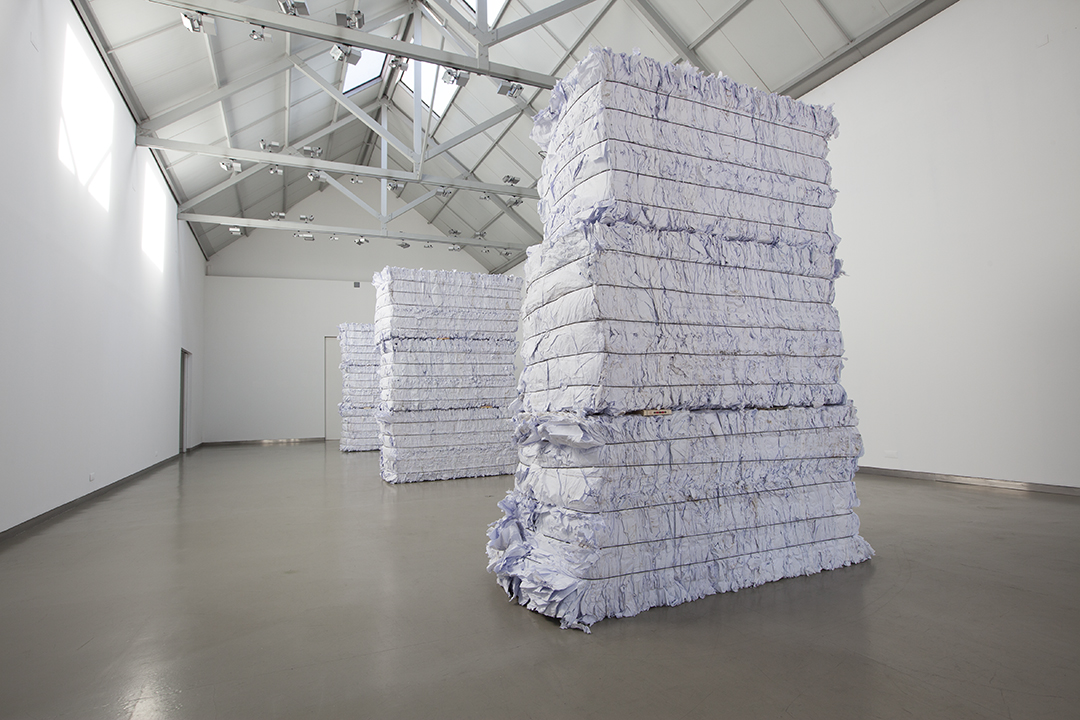

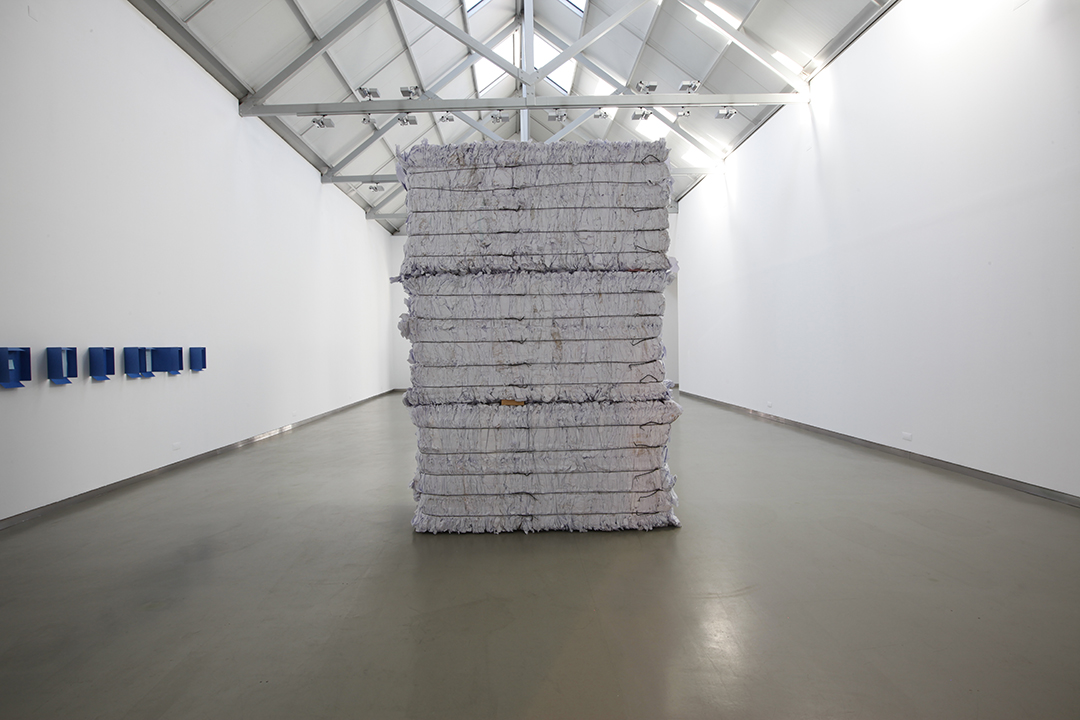

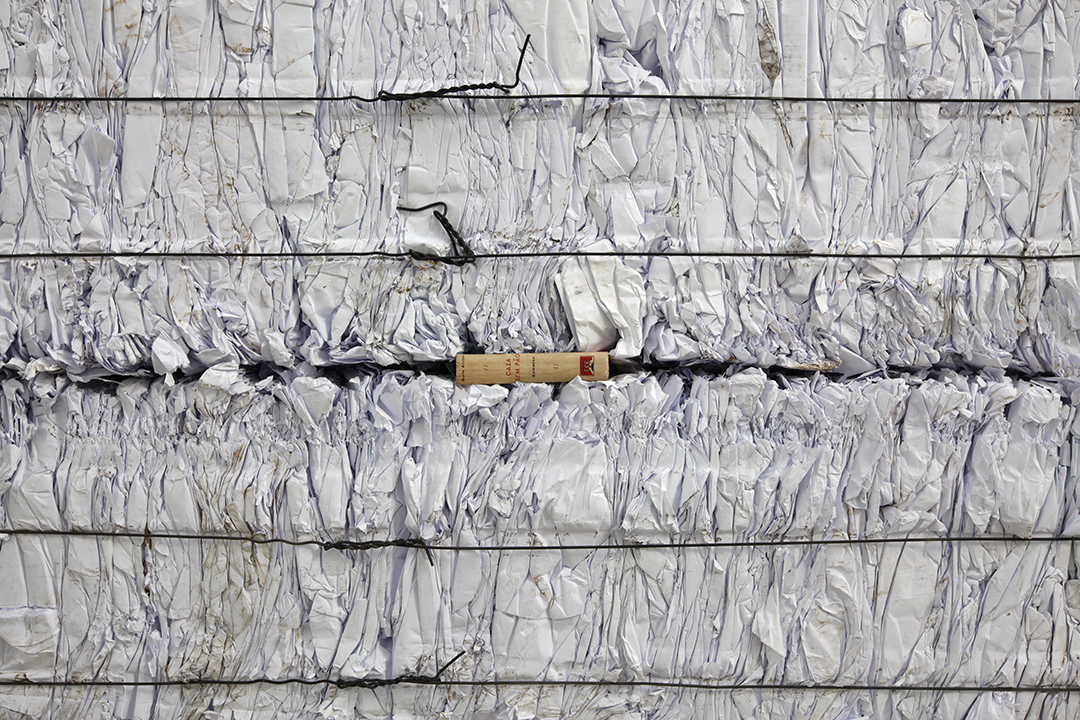
Exhibition view: Interdito, Galeria Filomena Soares, Lisbon, 2017
Installation | 9 bundles of white paper distributed in 3 piles, 14 books | 300 x 200 x 100 cm (each pile)Installation composed of bundles of paper tied with wire and stacked one on the other. Among the bundles, the artist placed some copies of forbidden books in Portugal (all writen by women, among them the famous Novas Cartas Portuguesas, 1972), which here are crushed by the weight of censorship, a crushing machine of creative and intellectual freedom. The physical and visual impact of its presence in space refers to the idea of the wall as a barrier and an inescapable symbol of interdiction. The artist challenges the viewer to navigate the space, to circulate between the volumes, fostering an interaction between body, object and space.
* Excerpt from text by Inês Grosso on the exhibition Interdito
Instalação-arquivo de caráter efêmero composta por fardos de papel amarrados com arame e empilhados uns sobre os outros. Entre os fardos, o artista colocou algumas cópias de livros proibidos em Portugal (todos escritos por mulheres, entre eles as famosas Novas Cartas Portuguesas, 1972), que aqui surgem esmagados pelo peso da censura, máquina trituradora da liberdade criativa e intelectual. O impacto físico e visual da sua presença no espaço remete à ideia de muro enquanto barreira e símbolo inescapável da interdição. A artista desafia o espectador a percorrer o espaço, a circular por entre os volumes, potenciando uma interação entre corpo, objeto e espaço.
*Trecho do texto de Inês Grosso sobre a exposição Interdito
O Leitor, 2017
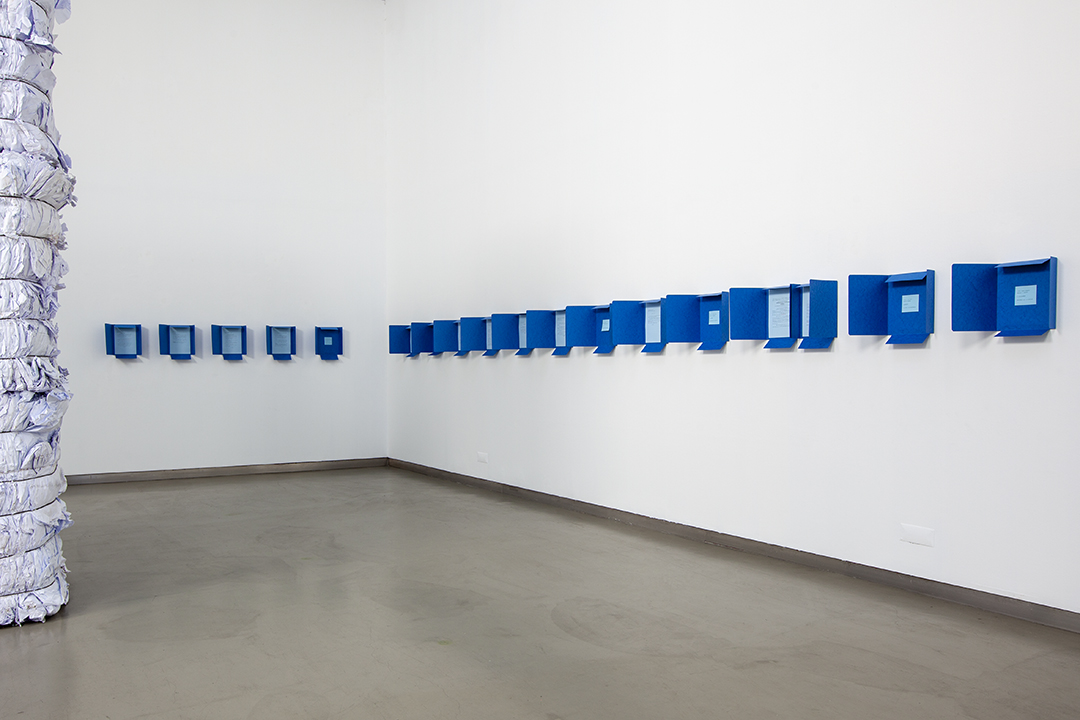

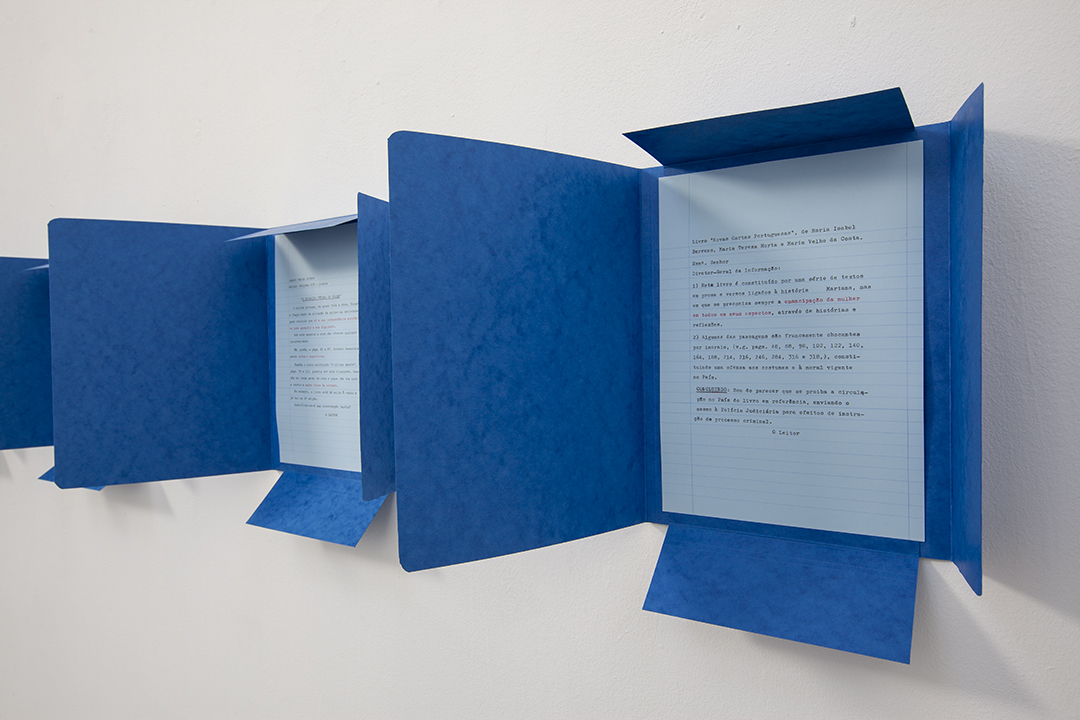


Exhibition view: Interdito, Galeria Filomena Soares, Lisbon, 2017
Installation | 18 paper folders, typewritten texts on blue paper | 32 x 24,5 x 32 cm (each folder)Reports and orders issued by Direção dos Serviços da Censura (censorship services in Portugal) typed by the artist herself on 25-line blue paper and highlighting red excerpts, expressions or words in a series of blue file folders. In the work O Leitor (The Reader), the result of a long and exhaustive research at Arquivo Nacional da Torre do Tombo (Public library in Lisbon), the word emerges as living matter, as a symbolic place of resistance, freedom and subversion.
* Excerpt from text by Inês Grosso on the exhibition Interdito
Relatórios e despachos emitidos pela Direção dos Serviços da Censura datilografados pela própria artista sobre papel azul de 25 linhas, destacando em vermelho trechos, expressões ou palavras numa série de pastas de pastas azuis. Fruto de uma longa e exaustiva pesquisa no Arquivo Nacional da Torre do Tombo, neste trabalho a palavra surge como matéria viva, como lugar simbólico de resistência, liberdade e subversão.
*Trecho do texto de Inês Grosso sobre a exposição Interdito
Biblioteca maldita, 2017 | Dito, 2017


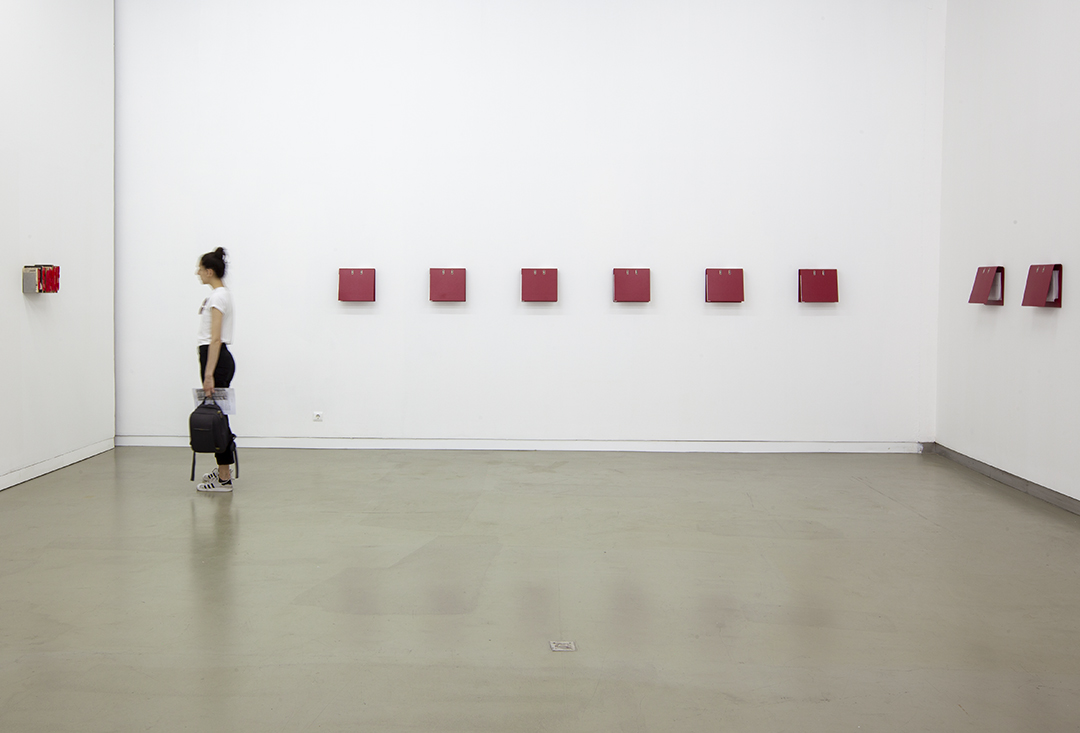


Exhibition view: Interdito, Galeria Filomena Soares, Lisbon, 2017
Biblioteca maldita | 15 books, Post-it red markers and steel bookshelf | 21 x 28 x 15,5 cmDito | 12 dossiers, mineral print on tracing paper | 30 x 32 x 5 cm (each)
Fifteen books written by female writers, playwrights and poets, that were forbidden and confiscated during the regime of the so-called Estado Novo in Portugal (New State, from 1933 to 1945) are presented on a shelf on the wall, as a small personal library that allows us to know more intimately the process and method of work of the artist in building their inventory of words and themes for the exhibition Interdito (Interdict). Natália Correia, Maria Teresa Horta, Pamela Moore, Nita Clímaco, Rosa Luxemburgo, Violette Leduc and Maria Archer are some of the names included in this collection.
On the same room, twelve red dossiers installed directly on the wall show pages printed on translucent paper that are waiting to be clad and read by the viewer. The artist creates thematic files, extolling some of the subjects, contents and words from books that, in a general way, were object of censorship during the regime of the so-called Estado Novo in Portugal (New State, from 1933 to 1945): joy, love, sing, body, desire, freedom, marginals (generic file with the words homosexual, lesbian, whore, prostitute, black, nigger, transvestite) woman, orgasm, word, poetry and silence.
* Excerpt from text by Inês Grosso on the exhibition Interdito
Quinze livros escritos por escritoras, dramaturgas e poetas, que foram proibidos e confiscados durante o regime do chamado Estado Novo em Portugal (1933 a 1945) são apresentados numa prateleira na parede, como uma pequena biblioteca que nos permite conhecer mais intimamente o processo e método de trabalho do artista na construção de seu inventário de palavras e temas para a exposição Interdito. Natália Correia, Maria Teresa Horta, Pamela Moore, Nita Clímaco, Rosa Luxemburgo, Violette Leduc e Maria Archer são alguns dos nomes incluídos nesta coleção.
Na mesma sala, um conjunto de dossiers vermelhos instalados diretamente na parede mostram páginas impressas em papel vegetal que aguardam ser folheadas e lidas pelo espectador. A artista cria uma espécie de arquivo temático, exaltando alguns dos assuntos, conteúdos e palavras que, de uma maneira geral, foram objeto de censura durante o Estado Novo em Portugal: alegria, amor, canto, corpo, desejo, liberdade, marginais (arquivo genérico com as palavras: homossexual, lésbica, puta, prostituta, negro, preto, travesti), mulher, orgasmo, palavra, poesia e silêncio.
*Trecho do texto de Inês Grosso sobre a exposição Interdito
Flyleaf, 2017-2022









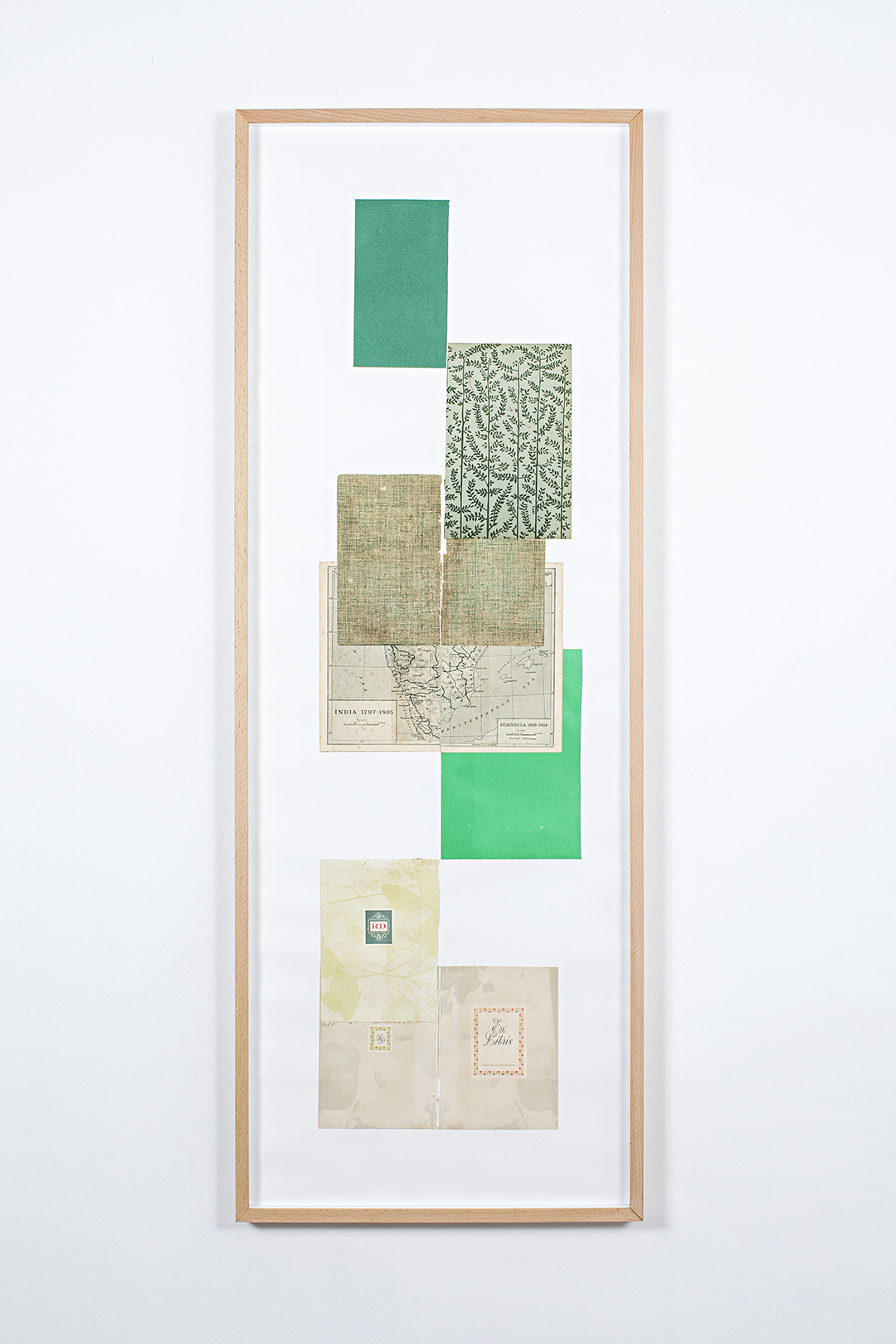
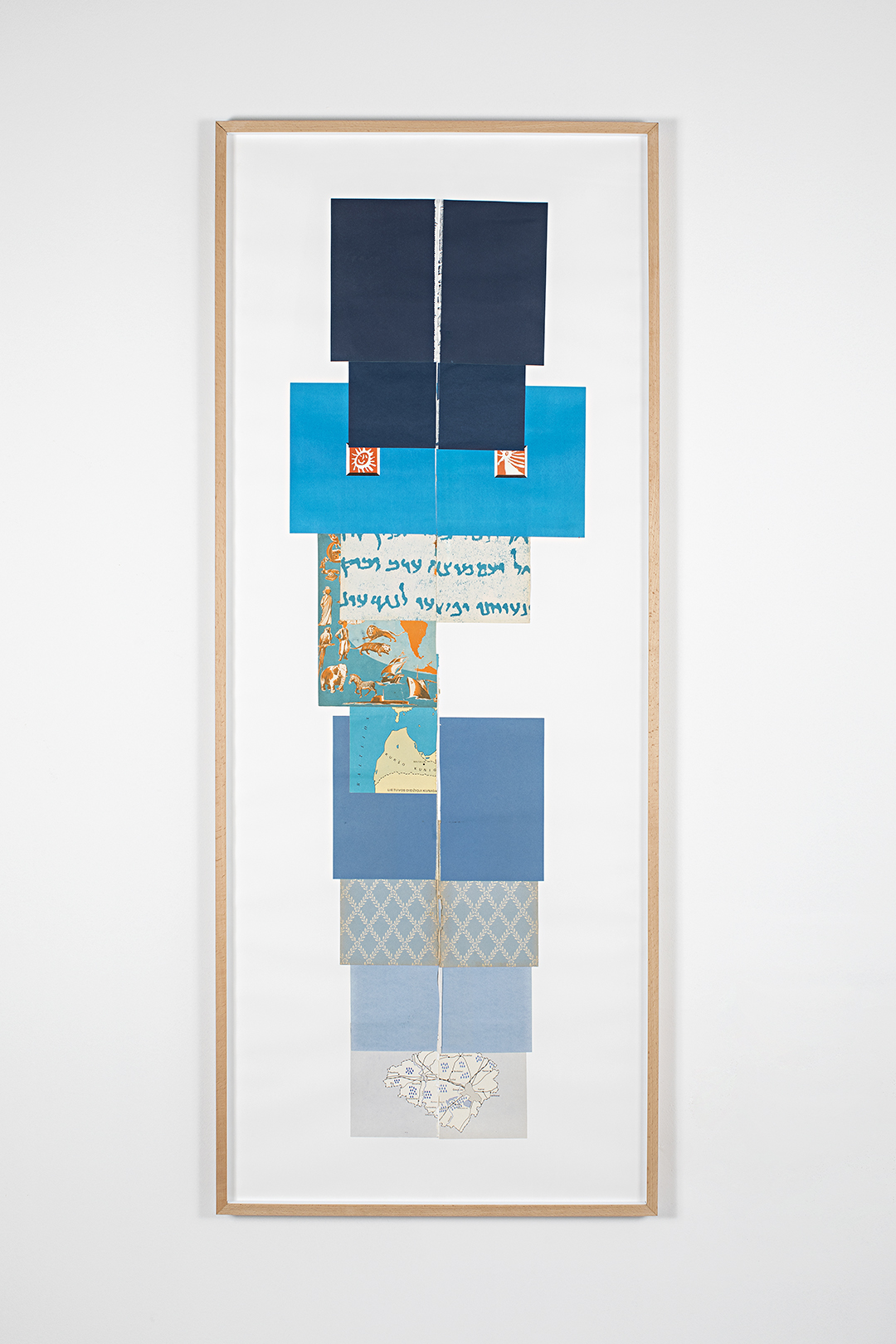

“Flyleaf” is the name given to those leaves folded in half and glued at the beginning and end of the book, to fasten the kerchief to the hard covers. They are usually decorated or of different color and material from other pages, and have the main function of protecting the core of the book. Flyleaf collage series are formal experiments in which flyleaves from various times and origins are superimposed according to their colors. Layers of graphic and sensory memories, vestiges of books that make us fly beyond their contents.
“Flyleaf” é o nome que se dá, em inglês, às folhas de guarda – aquelas folhas dobradas ao meio e coladas no começo e no fim do livro, para prender o miolo às capas duras. Geralmente são decoradas ou de cor e material diferentes das outras páginas, e têm a função principal de proteger o miolo do livro. As colagens da série Flyleaf são experimentações formais em que folhas de guarda de diversas épocas e origens são sobrepostas, de acordo com suas cores. Camadas de memórias gráficas e sensoriais, vestígios de livros que nos fazem voar para além de seu conteúdos.
A República, 2016
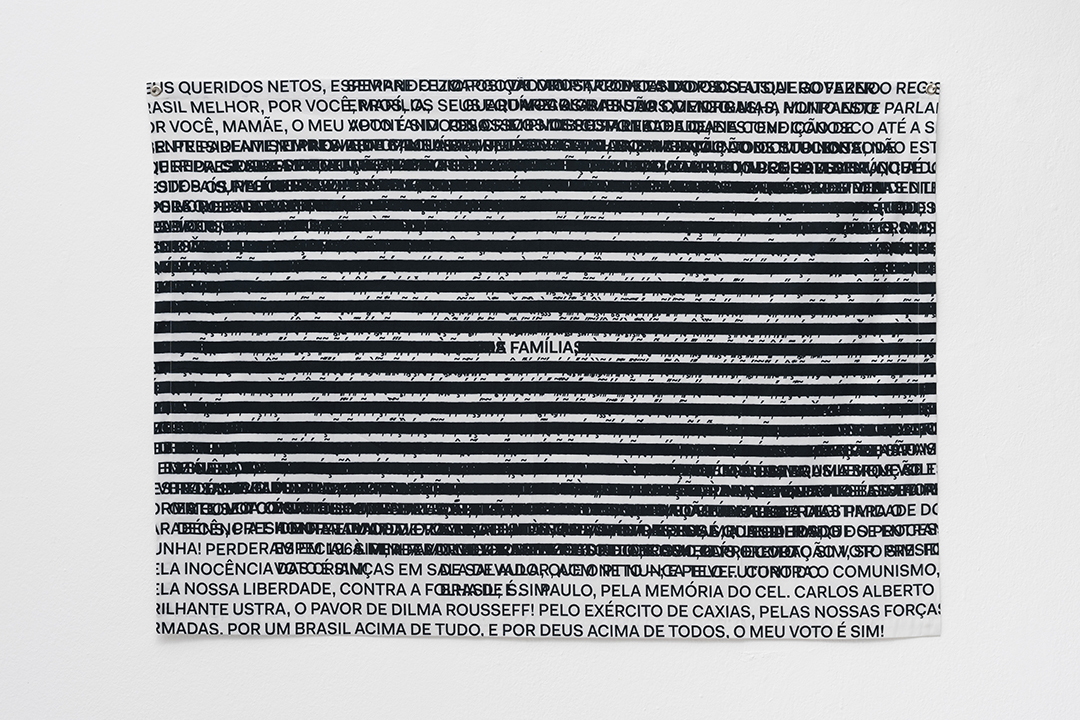

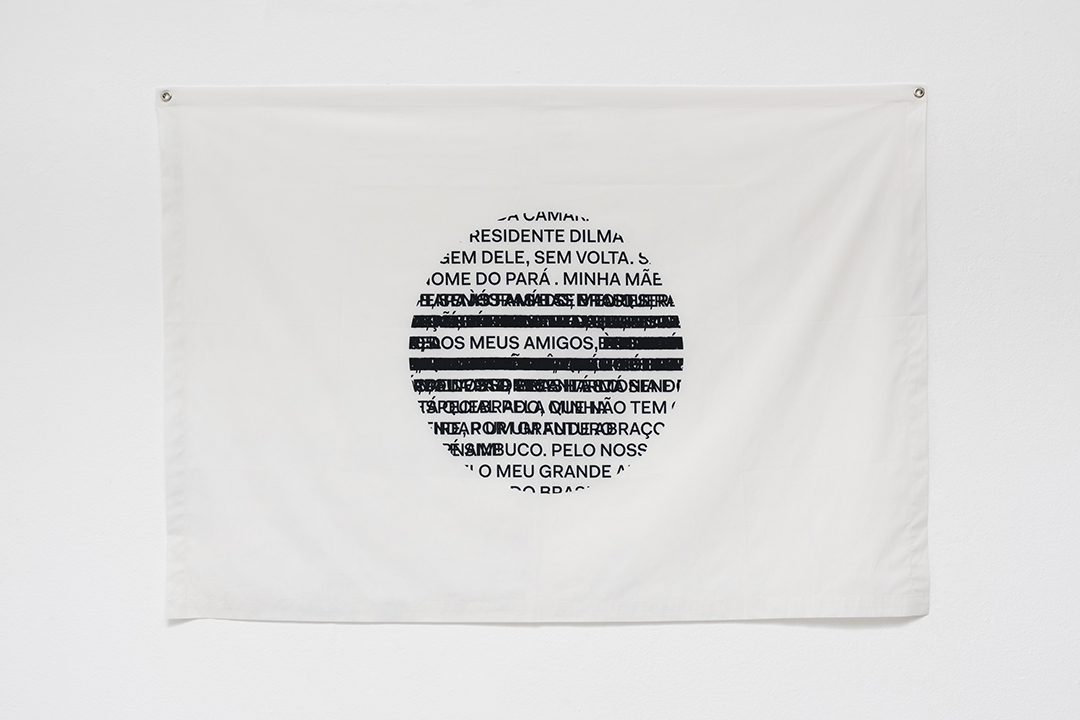

On the evening of 17 April 2016 Brazil’s Chamber of Deputies voted for the “yes” on the impeachment against the President of Brazil, Dilma Rousseff. Watched by tens of millions at home and in the streets, the vote – which was announced deputy by deputy – saw the conservative opposition comfortably secure its motion to remove the elected head of state less than halfway through her mandate.
The house’s 513 members voted one by one, each giving a short speech that rarely referred to the supposed reason for which Ms Rousseff is being impeached — her alleged fudging of the national accounts to hide a budget deficit. “In honour of my wife, who is not well, I vote Yes!” cried one lawmaker. Rightwing congressman Jair Bolsonaro dedicated his vote to Carlos Alberto Brilhante Ustra, the chief of secret police during the country’s military dictatorship of 21 years that started in 1964. Bolsonaro lauded him as “the terror of Dilma Rousseff”, a reference to her suffering as a Marxist guerrilla who was tortured under the dictatorship.
Each piece of A República (The Republic) is a composition in which the speeches justified by família (family), Deus (God) and os meus amigos (my friends) were superimposed in one of the Brazilian flag forms (rectangle, lozenge and circle).
Na noite de 17 de abril de 2016 a Câmara dos Deputados do Brasil votou a favor do processo de impeachment contra a presidente do Brasil, Dilma Rousseff. Assistido por dezenas de milhões de pessoas em casa e nas ruas, a votação viu a oposição conservadora confortavelmente assegurar o seu movimento para remover a chefe de Estado eleita a menos de metade de seu mandato.
Os 513 membros da Câmara votaram um por um, cada um fazendo um breve discurso que raramente se referia à suposta razão pela qual Dilma está sendo acusada – a alegada falsificação das contas nacionais para esconder um déficit orçamental. “Em honra de minha esposa, que não está bem, eu voto sim!”, alegou um deles. O então deputado Jair Bolsonaro dedicou sua votação a Carlos Alberto Brilhante Ustra, o chefe da polícia secreta que torturou a presidente durante a ditadura militar. Bolsonaro elogiou-o como “o terror de Dilma Rousseff”, em referência ao seu sofrimento.
Cada peça de A República é uma composição em que os discursos justificados pela família, por Deus e pelos meus amigos foram sobrepostos em uma das formas de bandeira brasileira (retângulo, losango e círculo).
Demão, 2016



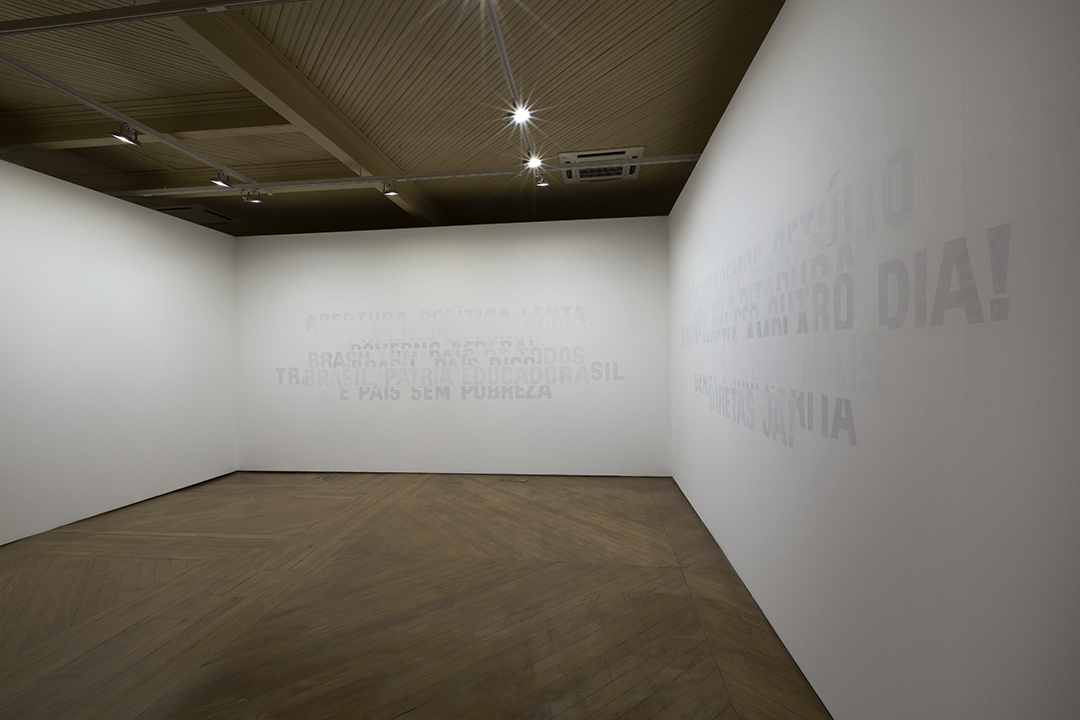
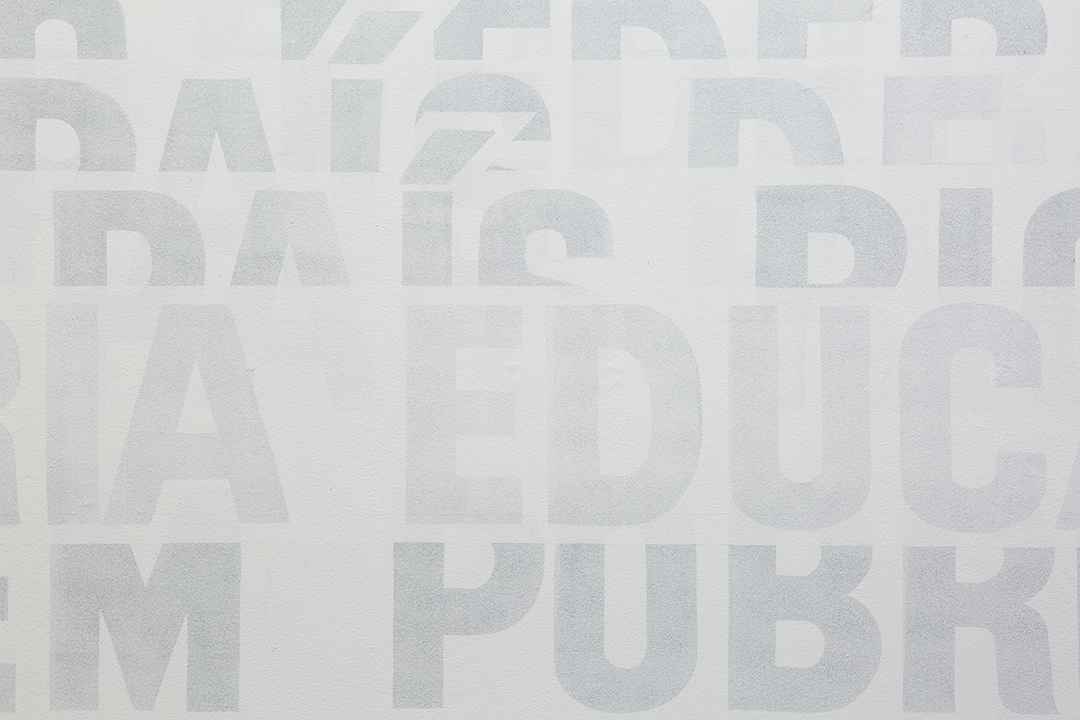

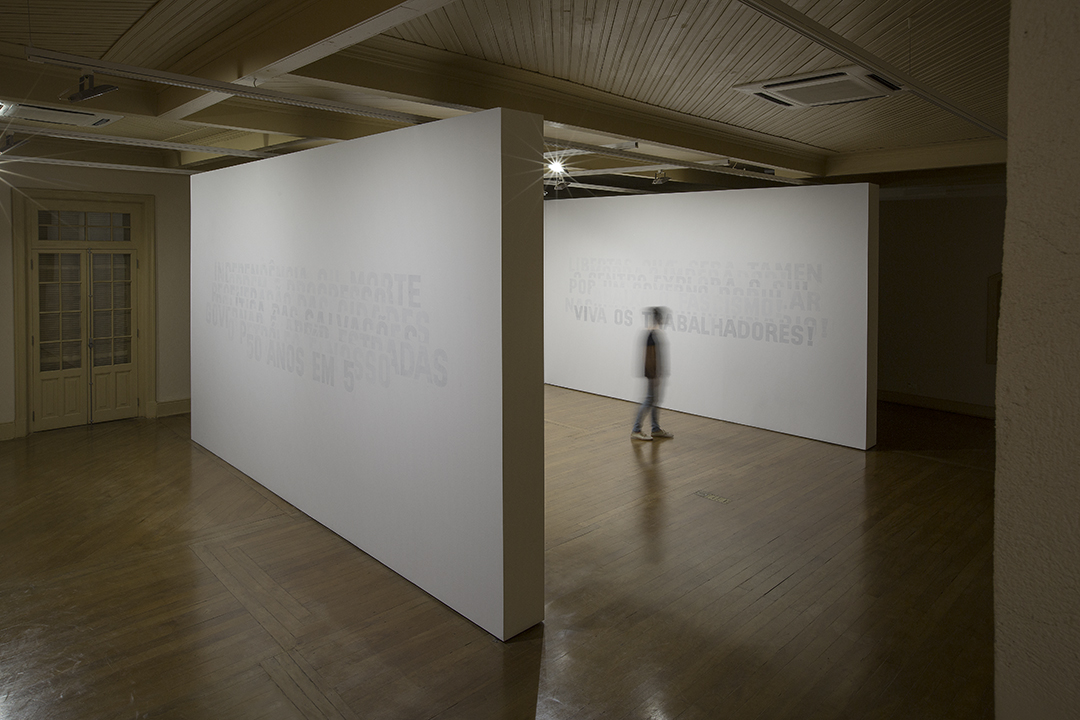



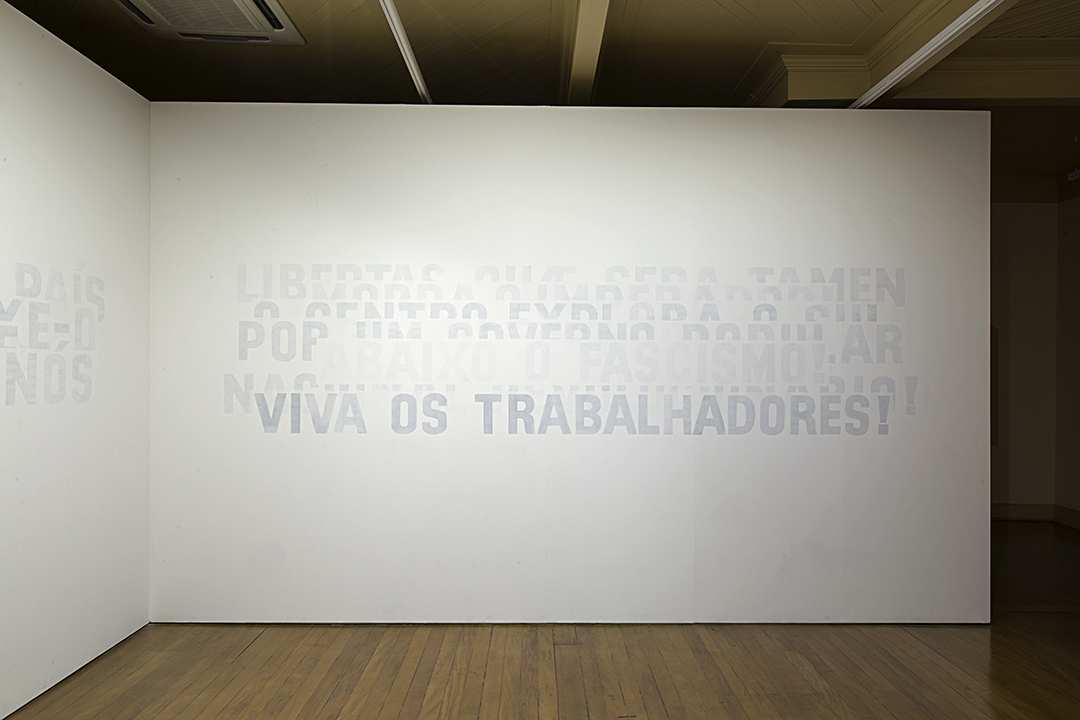


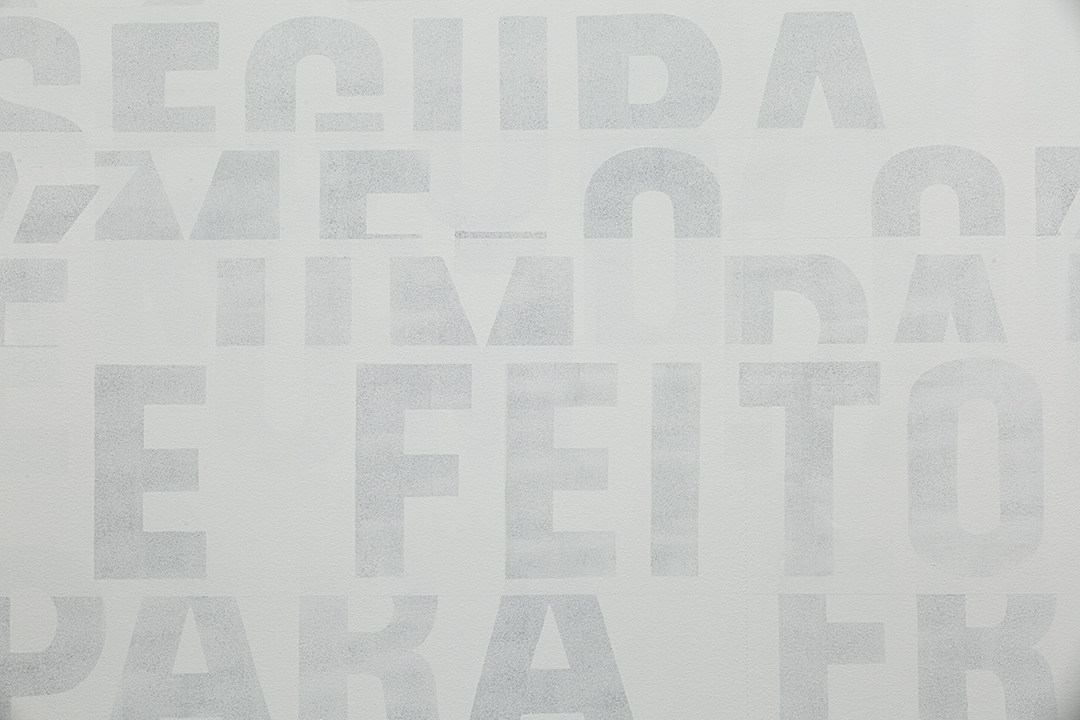
Exhibition view: Guerra do Tempo, Chácara Lane, São Paulo, 2016
Installation | Latex paint on 7 wood panels | Variable dimensionsBased on a historical research, I selected mottos and slogans of various federal administrations in Brazil and protest statements, ranging from “Independence or death” (D. Pedro I, 1822) to the current phrases. The sentences are painted on the exhibition panels at Chácara Lane by advertising painters who formerly painted political advertisements by the city walls. They are painted in black and veiled with white paint, overlapping in chronological order.
A partir de uma pesquisa histórica, selecionei lemas e slogans das diversas gestões federais do Brasil e frases de manifestações populares, que vão de ‘Independência ou morte’ à atual ‘não vai ter golpe’. As frases são pintadas sobre os painéis expositivos da Chácara Lane por pintores letristas, que antigamente pintavam propagandas políticas pelos muros da cidade. Umas sobre as outras, em ordem cronológica, as frases são veladas e sobrepostas, sem nunca apagar completamente a anterior, também ao modo do que acontece na cidade.
Código desconhecido (Chácara Lane), 2016
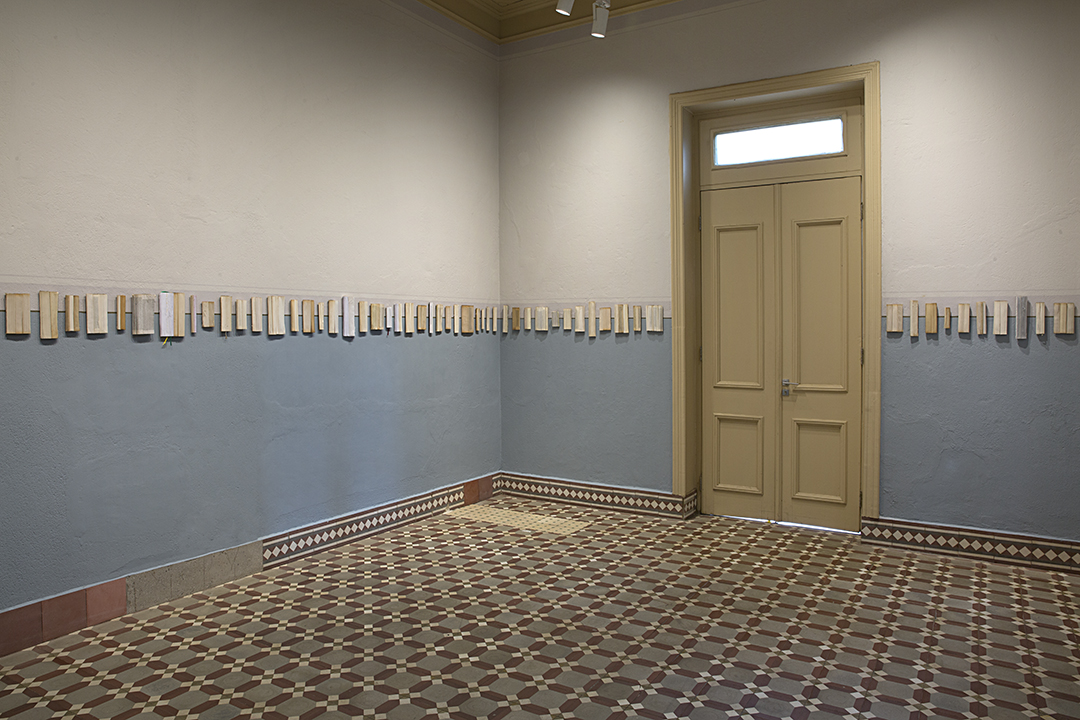

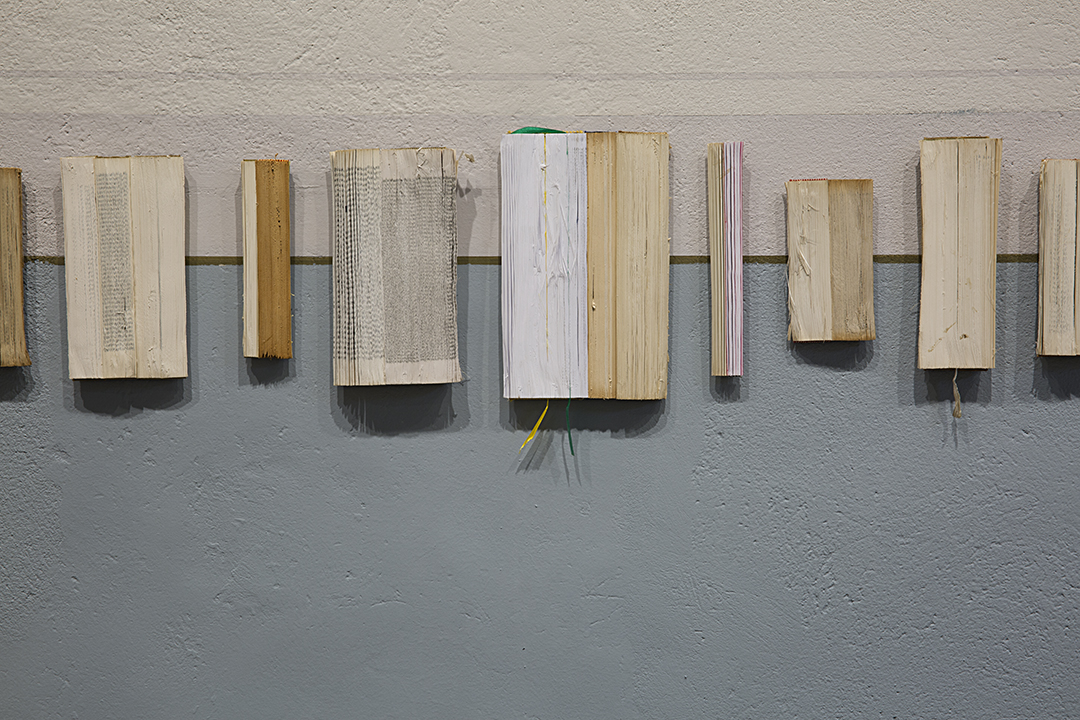
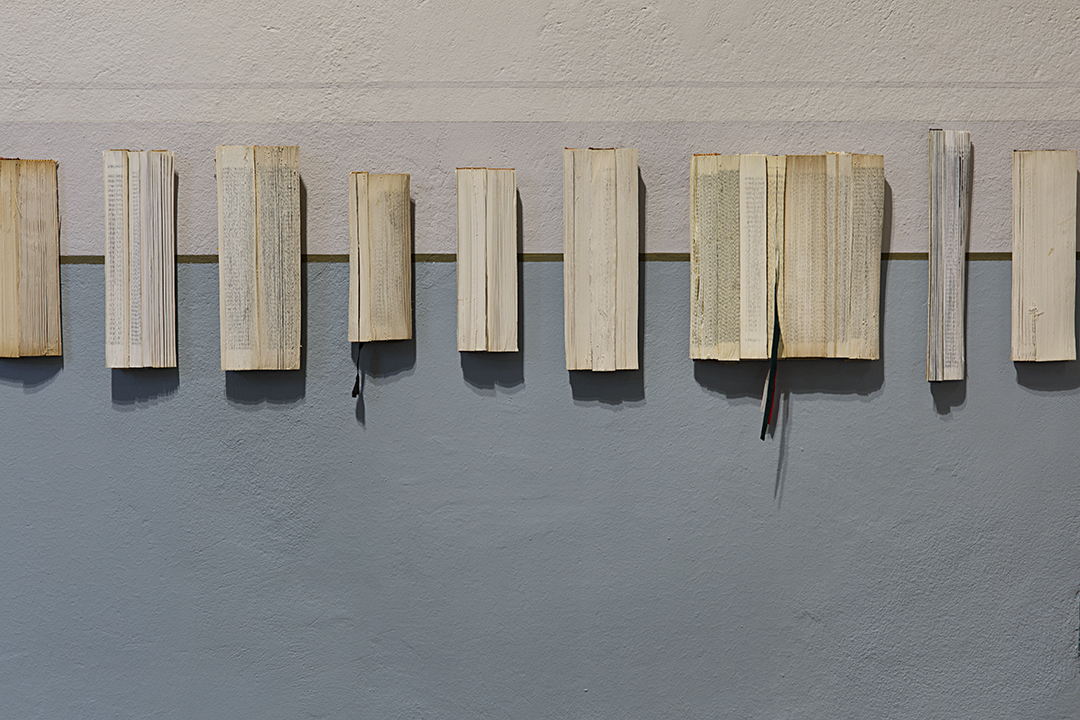
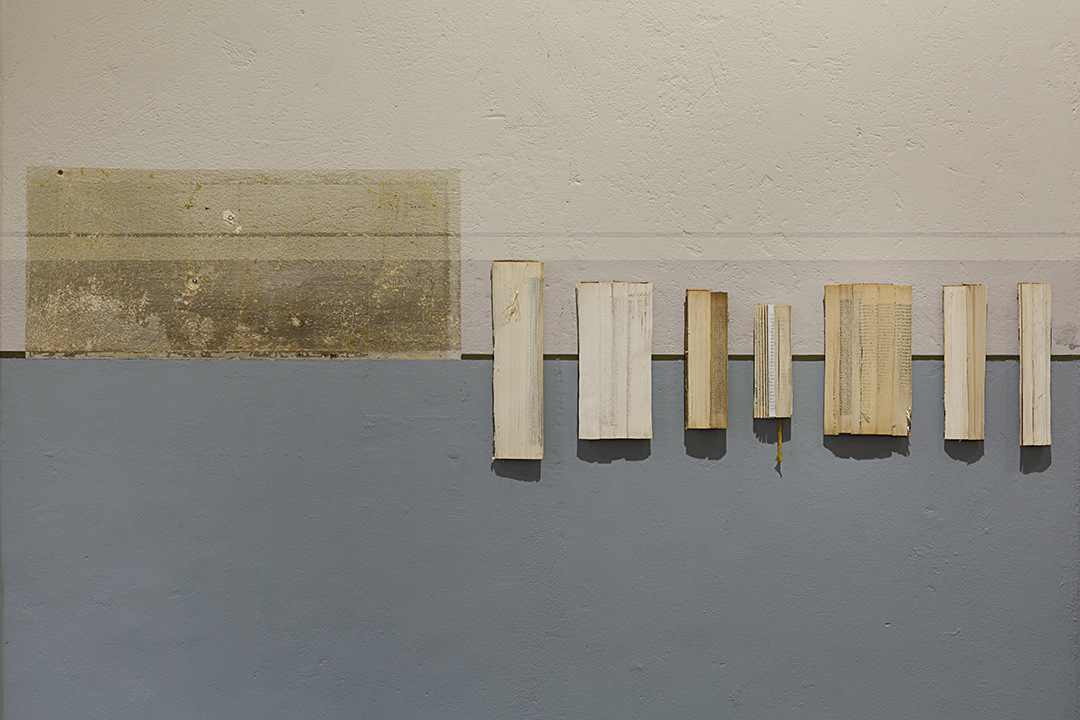

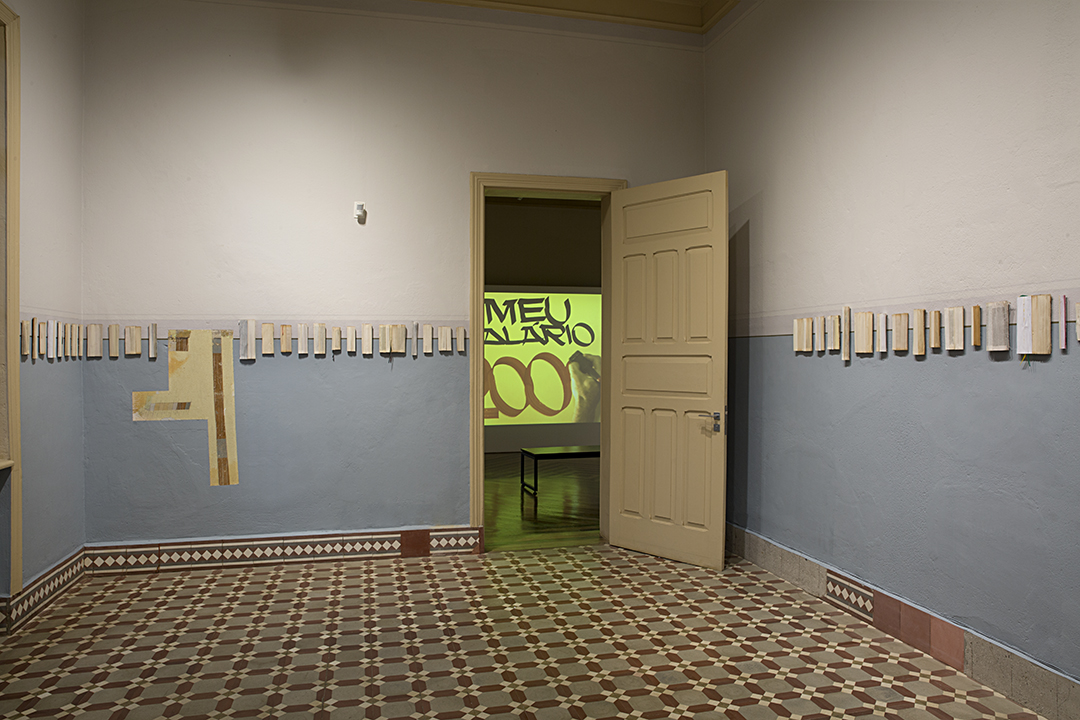
Exhibition view: Guerra do Tempo, Chácara Lane, São Paulo, 2016
Installation | Book spines glued to mdf, fixed to the wall with VelcroFrom the series Código Desconhecido (Unknown code), this work was specially made for the only room at Chácara Lane that was conserved as it used to be. Book spines organized by size into blocks that are similar to illegible bar codes. Once the narratives are vanished, we are left with their structure, which used to put the gathered pages in the correct order.
Da série Código Desconhecido, esta obra foi feita especialmente para a única sala da Chácara Lane que se conservou como antes. Lombadas de livros organizadas por tamanho em blocos que se assemelham a códigos de barras ilegíveis. Apagadas as narrativas, resta-nos a sua estrutura, o que costumava colocar as páginas em conjunto na ordem correta.
Quanto é? O que nos separa, 2015
Video / Performance| 10’43” | Color, sound
A close of yellow posters, like the ones that advertise offers in supermarkets, writen by a professional poster artist writes values collected in a research I carried out in the area of Praça Mauá, in Rio de Janeiro. In its first exhibition, during VISUALISMO ARTE TECNOLOGIA E CIDADE 2015, the video was projected on the facade of Edifício A Noite, while performer Felipe Fly improvised an interaction with the public guided by the research questions.
Praça Mauá is a place where people from all social classes, cultures, professions and backgrounds circulate, a sample of Brazilian society. Although we all share a country, there are huge economic and social barriers that segregate us.
Um plano fechado de cartazes amarelos, como os que anunciam ofertas em supermercados, nos quais um cartazista profissional escreve valores colhidos em uma pesquisa que realizei na área da Praça Mauá, no Rio de Janeiro. Em sua primeira exibição, durante o VISUALISMO ARTE TECNOLOGIA E CIDADE 2015, o vídeo foi projetado sobre a fachada do Edifício A Noite, enquanto o performer Felipe Fly improvisava uma interação com o público guiada pelas perguntas da pesquisa.
A Praça Mauá é um lugar onde circulam pessoas de todas as classes sociais, culturas, profissões e origens, uma amostra da sociedade brasileira. Apesar de convivermos todos ali, há imensas barreiras econômicas e sociais que nos segregam.
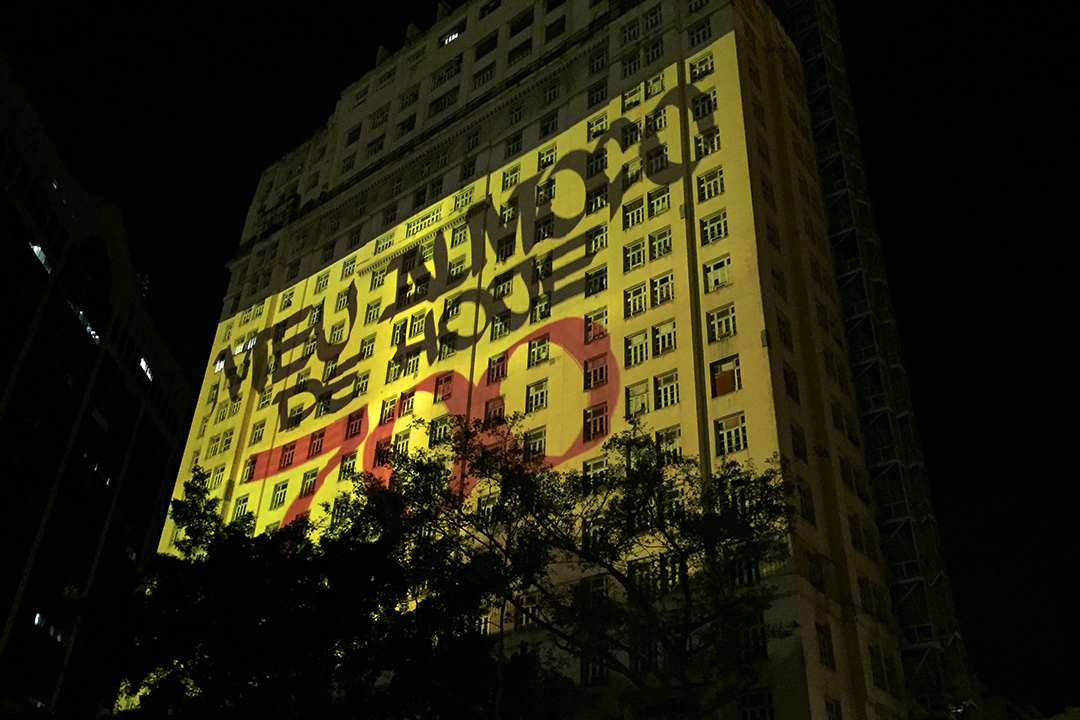
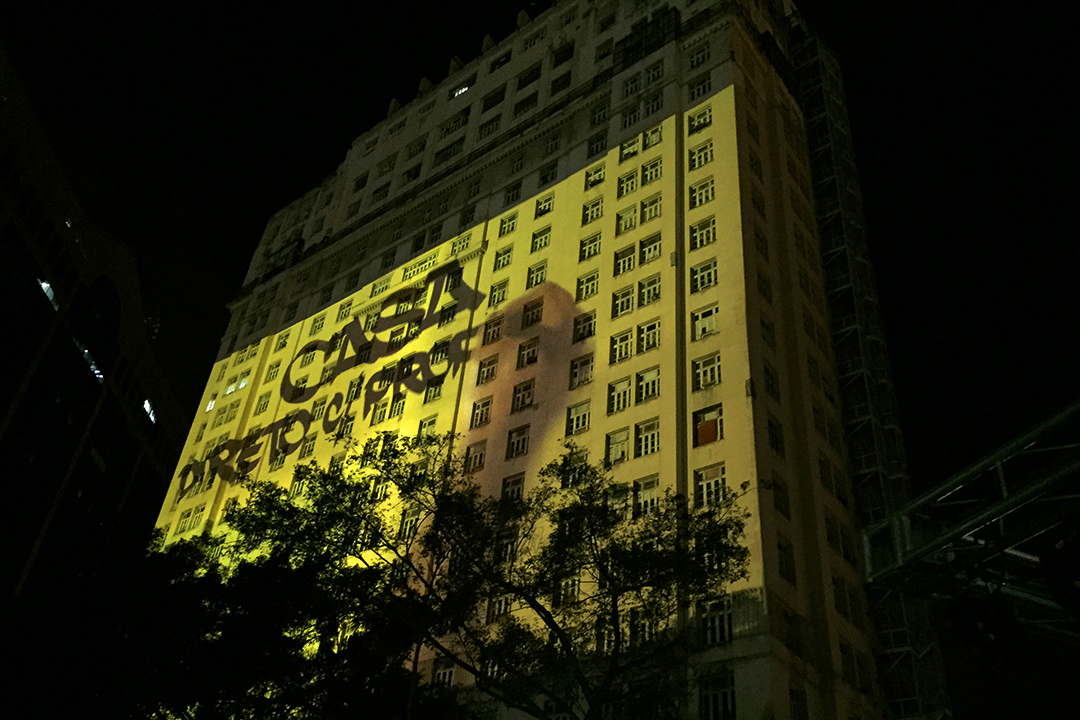
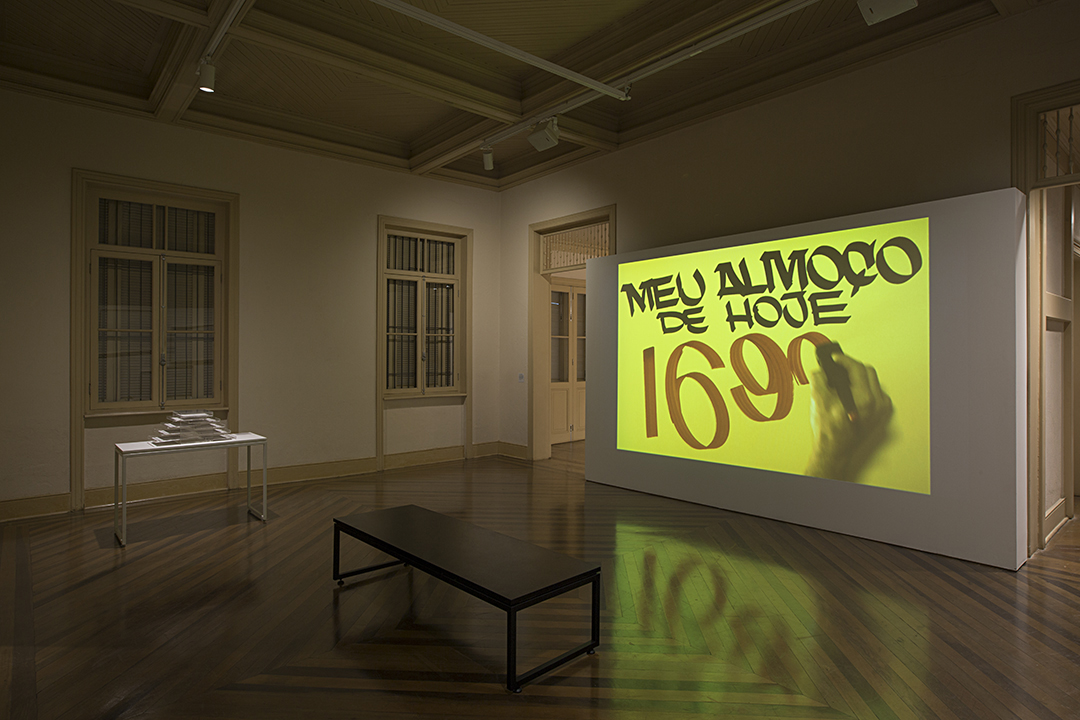
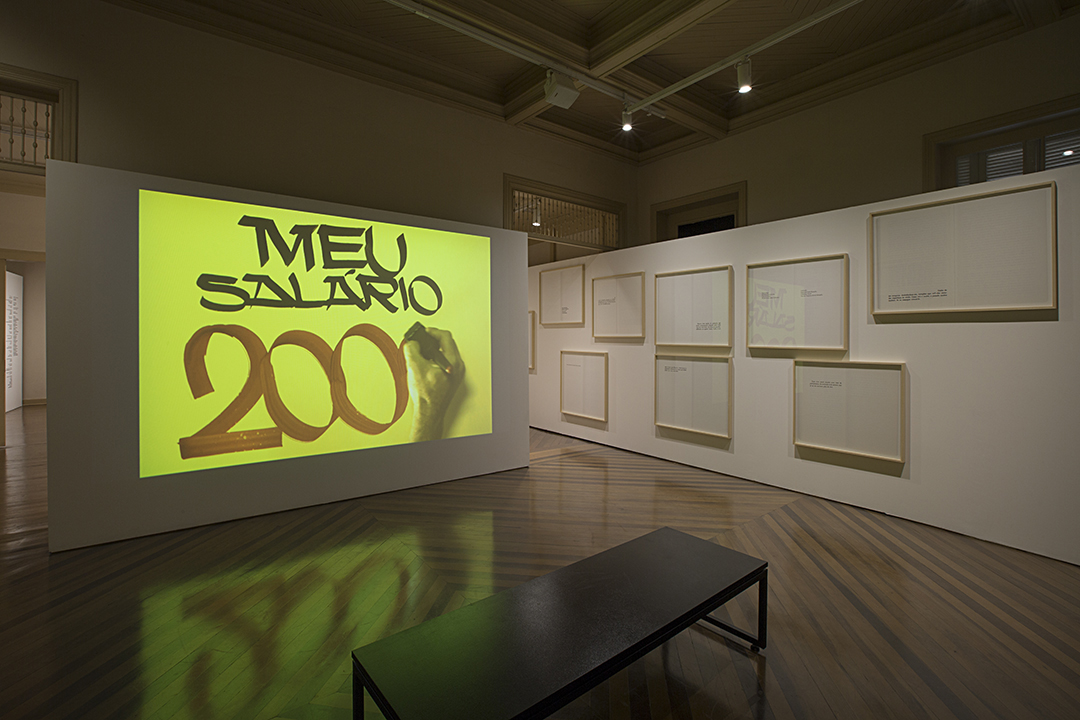
Diário, 2015
Single channel video 118’12” | Video installation (3 or 7 channels) | HD, color, soundFrom 8 to 30 January 2015, I made a video every day, using the most impactful of the headlines I read in Mexican newspapers. Written with water on the big concrete wall of the house designed by Tadao Ando, the headlines go off as soon as they are written, materializing the ephemerality of its impact. In the video installation version of the work, the anxiety is accentuated by the simultaneity of projections, and sometimes by some symmetry between the news.
* Work created during residency at Casa Wabi, in Oaxaca, Mexico
Watch the video installation documentation︎︎︎
Entre 08 e 30 de Janeiro de 2015, realizei um vídeo a cada dia utilizando a mais impactante das manchetes que lia em jornais mexicanos. Escritas com água sobre um grande muro de concreto, as manchetes apagam-se logo que são escritas, materializando a efemeridade de seu impacto. Na versão instalativa (3 ou 7 canais), essa angústia é acentuada pela simultaneidade das projeções, e por vezes pela simetria entre as notícias.
* Obra criada durante residência artística da Casa Wabi, em Oaxaca, México.
Assista a documentação da videoinstalação︎︎︎
Textos︎︎︎
Todo cinema é uma política, por Beatriz Furtado (Português)︎︎︎
Diário: a paixão do gesto, por Amanda Moura (Português)︎︎︎
As más notícias, por Maria Angélica Melendi (Português)︎︎︎
Las malas noticias, por Maria Angélica Melendi (Español)︎︎︎